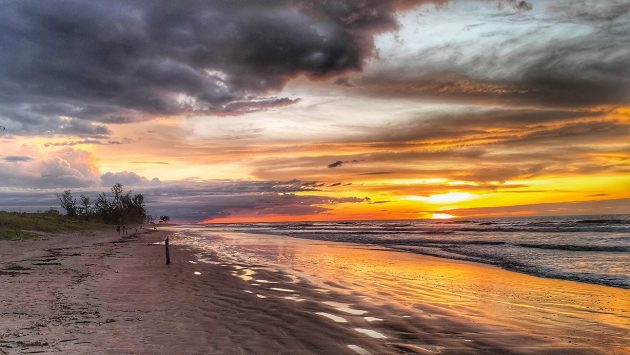Darwin, Australia’s ‘top-end’ city and port, is famous for its spectacular sunsets, infamous for its vicious monsoon weather and is well known for the region’s huge tidal ranges. This is all part of the fun for Robert Weatherburn in his friend’s 17ft trailer sailer
The Kimberly Coast of Northern Australia has the largest tidal range in the southern hemisphere. In Derby, to the west of Darwin, the tidal range has registered as much as 11.8 metres.
This range is tricky for trailer-sailors like ourselves: you must have a good grasp of how and when to launch in order to retrieve the boats as the tide moves quickly – get it wrong, and you could be stuck out there, floating around for another 12 hours.
Sailors must know the weather patterns, check all weather reports and forecasts, be aware that the online radar pictures show the weather as it is currently and, most importantly, never be complacent.
The waters are tricky, too. They are home to some of the sea’s most dangerous predators and ‘nasties’, such as: crocodiles, sharks, box jellyfish, stonefish and sea-snakes. (‘Did you see how the log near those rocks just turned and slithered away?’)
I was on a promise of a few days sailing at Australia’s top end with my mate Jake Gray. He met me at Darwin airport. ‘Grab your bag and let’s go! The boat is on the trailer on the ramp, food and water aboard. Wes is there already, and he’s coming with us.’

Trailer-sailing in and around Darwin requires knowledge and respect of the tides
Jake’s boat, Farr Farr Away, is a Bruce Farr 5000 design – a beamy 2.5m-wide boat with the beam carrying well aft towards the wide stern, where the average crew will spend most of their time in the cockpit. It has an overall length of 5.09m, and a waterline length of 4.62m. Farr Farr Away slipped easily into the water.
Risk averse
It was early February, and I couldn’t help but notice that there were no yachts out sailing, nor any others lying to moorings. I asked Jake why not, and he explained that during this monsoon season, one has to be sure there won’t be thunderstorms around. Because of the storms, many club members won’t risk getting caught out by vicious squalls or violent electrical storms, and nearly all their yachts were either ashore or on safe moorings elsewhere.
I was the last one over the transom as we moved away from the ramp, heading SSW with the light breeze coming from the north-west. Jake left me at the tiller and set the sails, and we bore-away on port tack. A perfect launch.
‘Are you happy with the set of the sails on this heading?’ Jake asked me. ‘Yes they’re fine. Where are we heading?’

Safe moorings in the city of Darwin
‘Hang on,’ Jake said, ‘I just want to check the latest weather models and observations – there’s likely a small low hanging offshore. I don’t know if it’s deepening, but we usually find out overnight. If it gathers strength it might bring squalls and a gnarly swell with it, and it could make recovery difficult – but stay on this bearing for the moment.’
Farr Farr Away was sailing easily and well, but I could see a gathering darkening cloud off to starboard. This was probably what Jake was concerned about. Wes handed me up a cup of tea, and I realised that the wind was picking up, and that I could feel it in the tiller.

Sunset over the rocks at Darwin’s famous Mindil Beach
One cup of tea later and Jake was right. The low was deepening and thunderstorms were popping up in all directions. Distant lightning was flickering non-stop where the low was sitting in the north-west and a deeper swell was building.
‘OK,’ Jake said, ‘I did think we could go through into the harbour past Emery lighthouse, and look around the harbour, but I reckon we should make out to the other side of the harbour. There’s a fairly well-sheltered beach there and it’s beautiful. It might be fun to beach the boat there, and stay overnight, sleeping in the boat.
‘We’d have to take it in turns for one of us to stay awake, though – Farr Farr Away’s stern is low to the water, and there are crocs around. There’s plenty of food and water aboard, but don’t throw anything overboard – we don’t want to encourage a visit by a hungry dinosaur.
‘The storm generated by the low should have died down by morning, and when we’re afloat again we could make it back to recovery around 1400. I’ll check the tides and times. How about that? Just chill out with the crocs?’
It wasn’t what I expected for the first day’s sail at Australia’s top end, but it was certainly different. Many thanks to Jake.
Enjoyed reading this?
A subscription to Yachting Monthly magazine costs around 40% less than the cover price.
Print and digital editions are available through Magazines Direct – where you can also find the latest deals.
YM is packed with information to help you get the most from your time on the water.
-
-
- Take your seamanship to the next level with tips, advice and skills from our experts
- Impartial in-depth reviews of the latest yachts and equipment
- Cruising guides to help you reach those dream destinations
-
Follow us on Facebook, Twitter and Instagram.





